Photo

Flier from a talk a few weeks ago at the University of Illinois at Chicago, HWGL and OCD founder @clara.balaguer presented a long distance lecture on decolonizing through print, researching the invisible and living a long distance life. (at University of Illinois at Chicago)
6 notes
·
View notes
Photo
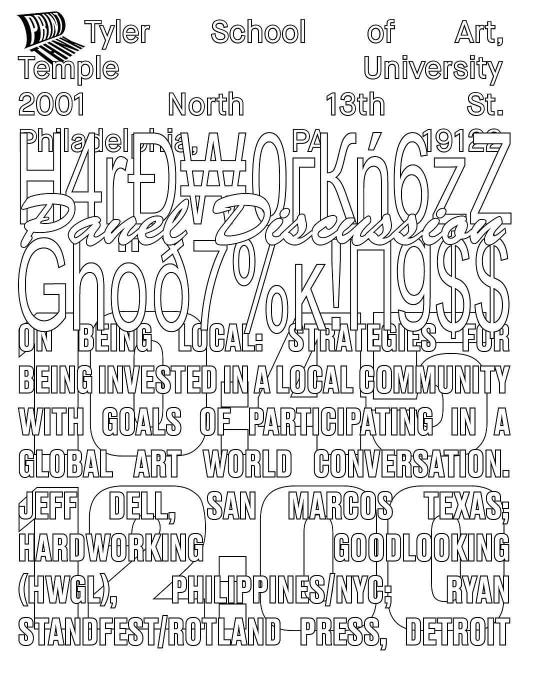
Tomorrow, HWGL head of design @kristian_henson will be part of a panel on globalized art and publishing networks at Tyler School of Art in Philly!! Print Think 2016 (at Tyler School of Art)
7 notes
·
View notes
Link
A peek into the research we are doing on the history of Philippine graphic design, published by Triple Canopy.
10 notes
·
View notes
Photo
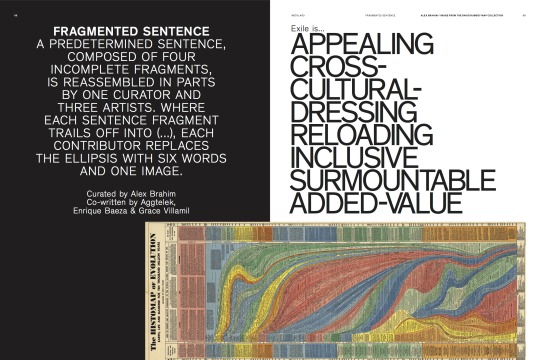

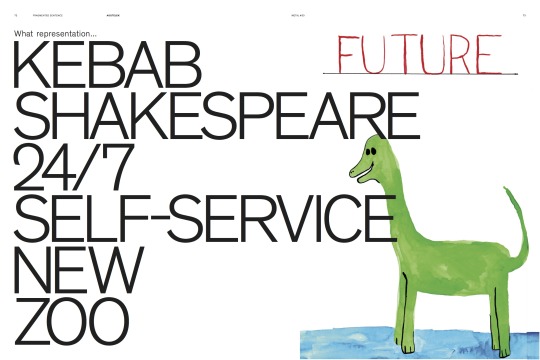

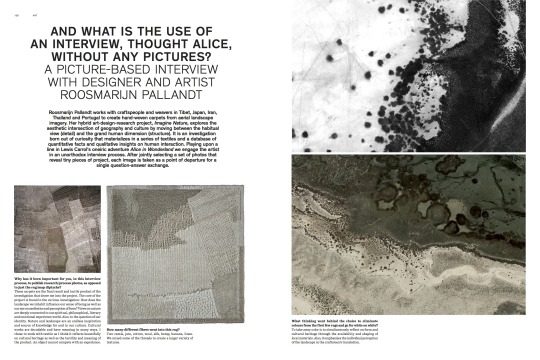

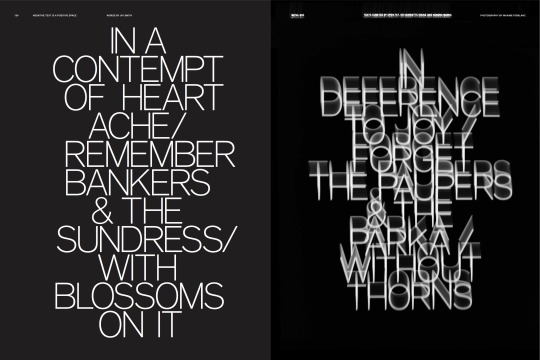

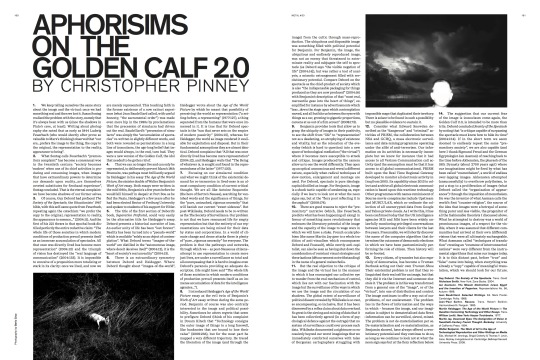
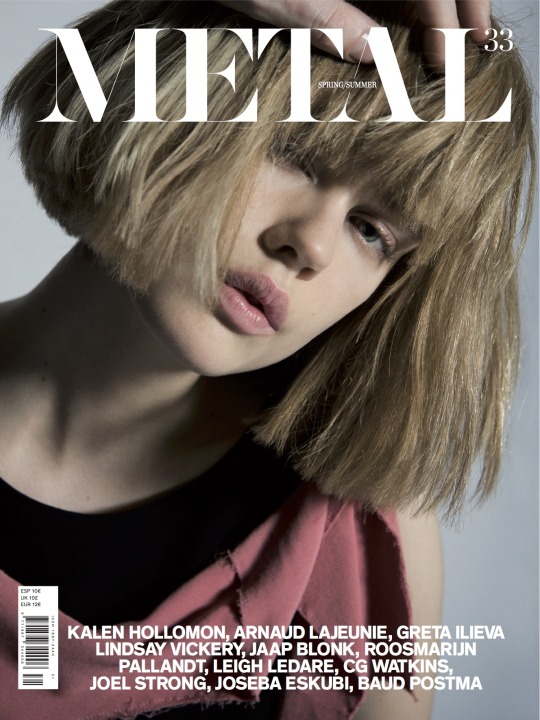
A selection of Edit for Metal #33: Part 1
We were asked to guest edit the 33rd issue of Metal Magazine. Which is a fashion magazine. A fancy one. So we decided to do a hidden issue of Edit, our migrating magazine supplement, within its pages.
Here are some sections:
Fragmented Sentence
A sentence written in parts, each part completed by a different artist using 6 words and one image. Curated by Alex Brahim. Written by Aggtelek, Gracia Villamil and Enrique Baeza.
Essays and Interviews
Leigh Ledare
Christopher Pinney (Photo by Geric Cruz)
Roosmarijn Pallandt
And here is our editorial (foot)note.
IN THE ERA OF CUT AND PASTE, THE GLUE-EATER IS KING
A SUB-EDITORIAL FOOTNOTE BY HARDWORKING, GOODLOOKING
For better or for worse, the primacy of imagery and the growing inscrutability of words form a new, frankly overpopulated paradigm for how we interact with each other. Metal 33 wants to explore the phenomenon of represented image as our new DNA, and how words fit into the equation not as meanings but as signs. [FRAGMENTED SENTENCE]
The rise of the hyperreal images— still or moving — and of virtual spaces — real or fantastic — to media dominance has changed the scape and scope not just of how humans communicate but also of how man perceives himself in relation to the external world of stimuli.
Where there was a certainty of our corporeal materiality, of existing within our bodies as separate, sentient beings who experience the world subjectively in order to gain objective insights, there is now a blurring of borders. Technology is able to represent our image in photographs, holograms, moving images that are transmitted over distances with a speed that is not native to our physical bodies. These images are experienced, with more and more exactitude, as projections of our selves that in many cases supplant our physical presence—our actual selves. Our image is friction enough to affect the orbit of others. [HIEROGLYPHIC INTERVIEW] Our presence is in danger of being reduced to an incidental, or worse yet, to a hashtag. This is an effect that we have chosen, though we may perceive of it as being imposed on us by circumstance. [LE TIT] The speed at which information is generated gives rise to anxiety, because we have not yet fully discovered the means of codifying corpulent data into digestible chunks fit to the scale of human consumption. The ball must surely lie in the status quo’s court, wethinks.
And so we become increasingly afraid of or indifferent to the effort it takes to comprehend the world that we have created. Be it because of the laziness or fear, we are a sliver away from bashing our collective unconscious heads on the rocks of surplus information, a hard place ironically made possible by technologies of our own making. [APHORISMS ON THE GOLDEN CALF 2.0] Increasingly, there is a paranoia that our inventions (or their side effects) will ultimately control us, or are doing so already. This crisis of identity — at its essence, an uncertainty of who or what delineates our sense of identity if we cannot understand it — is exacerbated by the fact that the more we advance and the more “knowledge” we create, the less we want to know and the more we cleave towards nonsense. We retreat into entertainment and non-consequential information as a defense mechanism and for respite. As the media theorist Neil Postman posits, we are entertaining ourselves to (symbolic) death. Perhaps the problem is that many of us are trying to swallow the whole instead of ruminating on the atomised parts. [ALTERNATED MUSIC] In this frame, what emerge are inversions/confusions in the realm of how we communicate or represent ourselves. These new developments are not always perverse, mere forms of mindless entertainment. They are the symptoms of our current human condition and its increasing indefinability. Since postmodern semiotics and the way its ideas have been re- or mis- or dis-translated into media, the image is not always meant to be recognised for what it is, nor are words to be understood for what they traditionally mean. It is in this fullest of voids where things are not understood linearly, in this negative space [NEGATIVE TEXT IS A POSITIVE SPACE] that is created by surplus of things and meanings, where all things may take on inverse meanings, and all functions or roles may be cross-pollinated. The reading that is taken from these wilful confusions is of primal importance: instead of ending in disinformation, these (mal)formations could lay bare the essence of things. When we understand how a system, institution, object or estament may be subverted from a whole into its smallest of parts, it follows that we discover how the entire thing (mal)functions. Armed with this awareness, with an understanding of all the contradictions, these particles might be reconstructed into a whole new order of signification that makes sense to us now, for a moment, before obsoletion sets in and we all turn into cyborgs. [“AND WHAT USE IS AN INTERVIEW,” THOUGHT ALICE, “WITHOUT ANY PICTURES?”]
4 notes
·
View notes
Photo
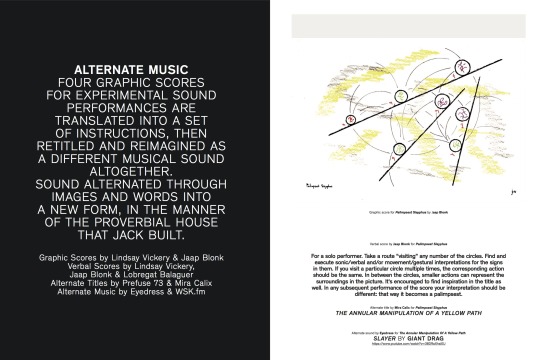
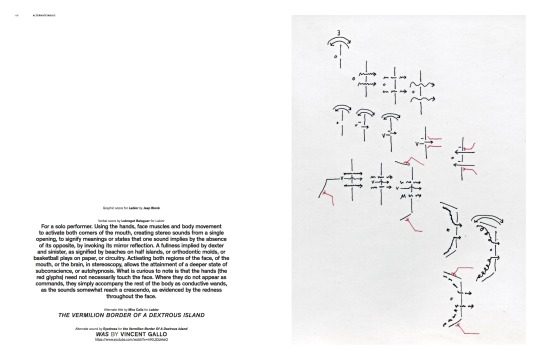
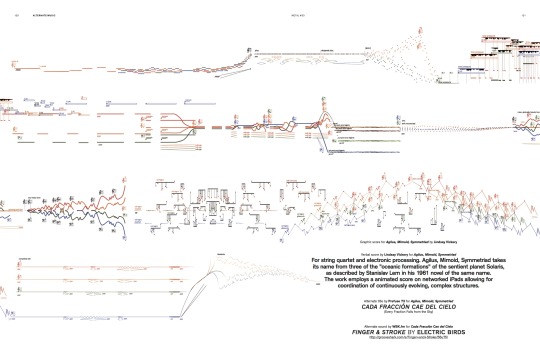
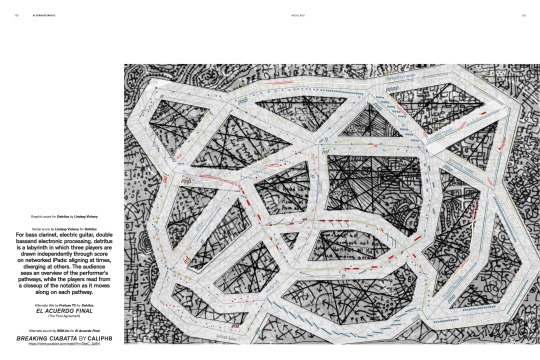

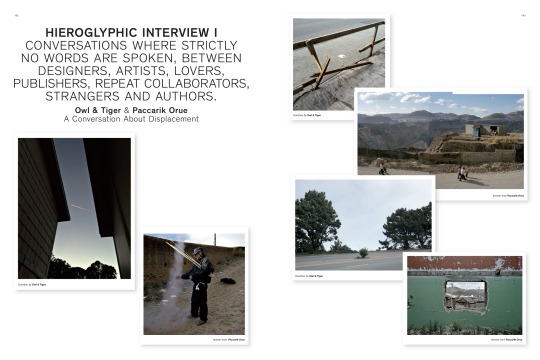



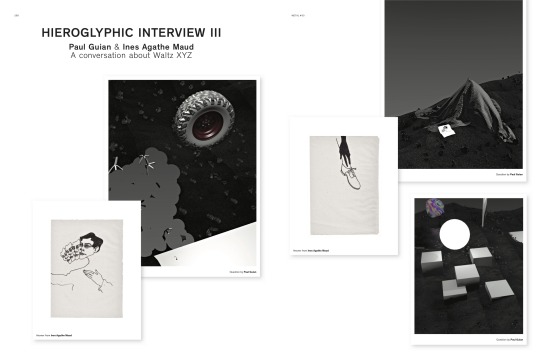
A selection of Edit for METAL #33: Part 2
Here is a selection of the rest of the sections we guest edited for the 33rd issue of Metal Magazine, the last one designed by Miquel Polidano. A real collectors item for fans of the magazine.
Alternate Music
Visual scores to musical performances (Jaap Blonk and Lindsay Vickery), translated to words, given a new title (Prefuse 73 and Mira Calix) and then finally given an alternate musical sound (Eyedress and WSK.fm).
Negative Text is a Positive Space
Mini poems translated into direct antonyms. Edited by Henriette Kruse Jørgensen and Kendra Marks of open.txt. Poems by Cecilie Nellemann, Isabel Seiffert, Jay Smith, Jun K Lee, Merete Røstad, Ricky Leach and Shelby Thompson.
Hieroglyphic interviews
Q&As conducted using only pictures. By Casco (Yolande van der Heide) and Christian Nyampeta; Owl and Tiger (Patrick Aguilar) and Paccarik Orue; Ines Agathe Maud and Paul Guian.
3 notes
·
View notes
Photo
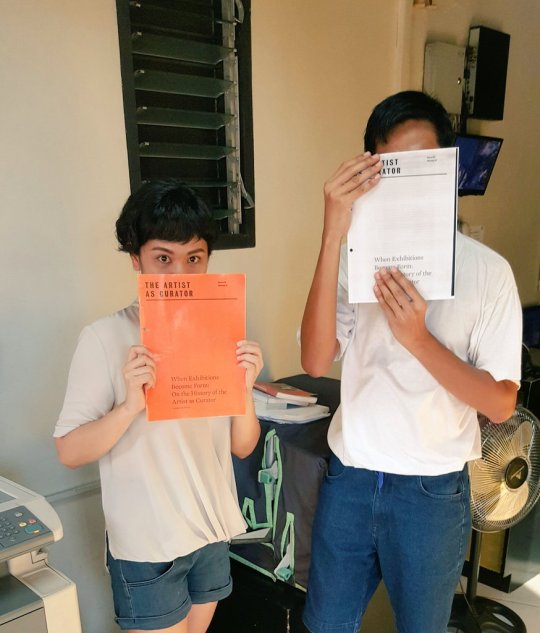
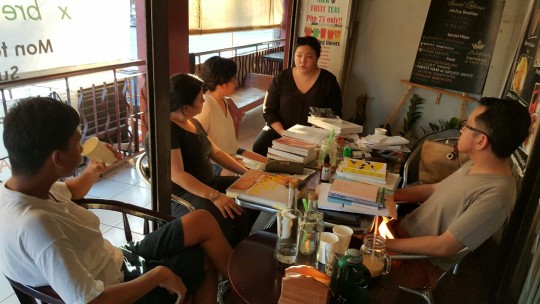
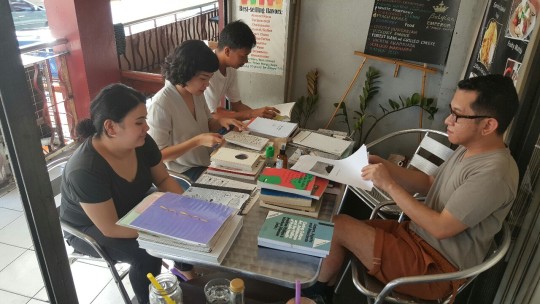
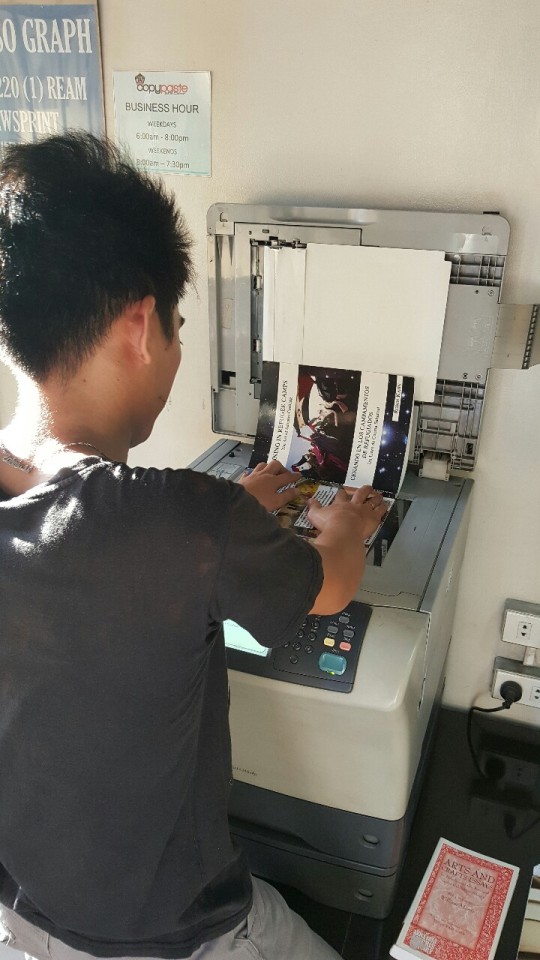
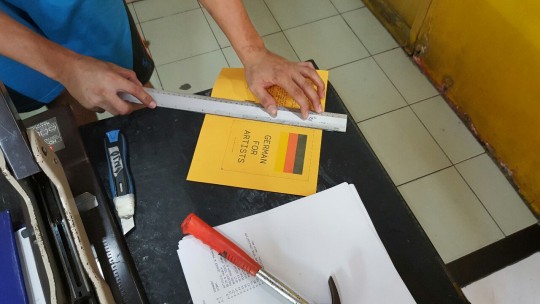
SUCAT. XEROX. HOHOL (HANG OUT HANG OUT LANG).
It’s pretty hard for art practitioners here to find good research and reference material. Also, Manila is such a huge city that people who live in the artsy north of the city don’t generally get to hang out and talk shop with friends from the bucolic south. This loosely organized small party kills two birds with one stone.
SXH was held at a middle class-swank coffee hauz (with real espresso!) along a nondescript portion of Sucat Road. Right next door, a fully equipped copy shop. Perfect location for exchanging books and thoughts on a ragingly hot El Niño summer day.
A different way to spend your Sunday afternoon. Productive HOHOL is where it’s at.
Thanks billions to Czar Kristoff, Nice Buenaventura, Tammy David, Karen Batino and Renan Laru-an for schlepping over to this side of town!!!! And for all the shop talk!!!! And the gossip!!! And the books!!!!
4 notes
·
View notes
Photo
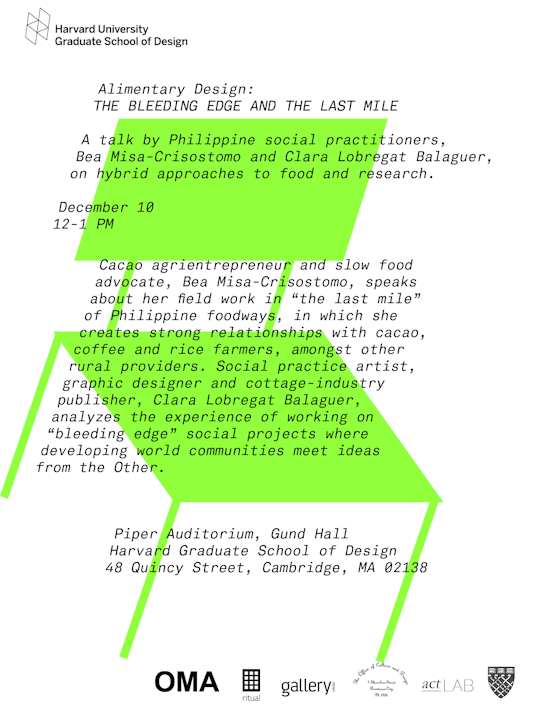

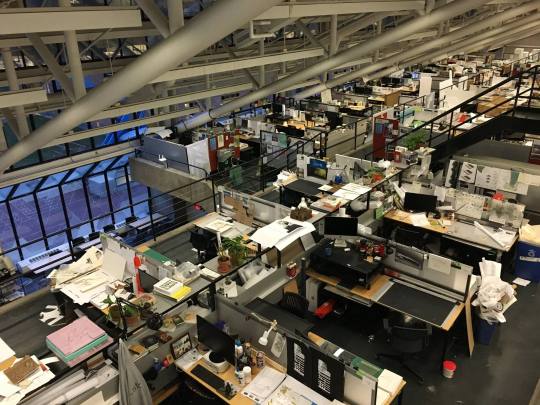
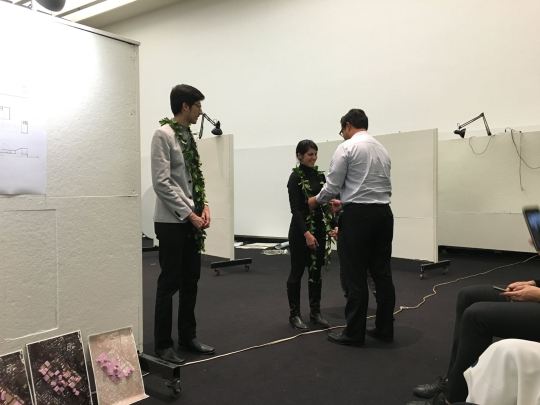

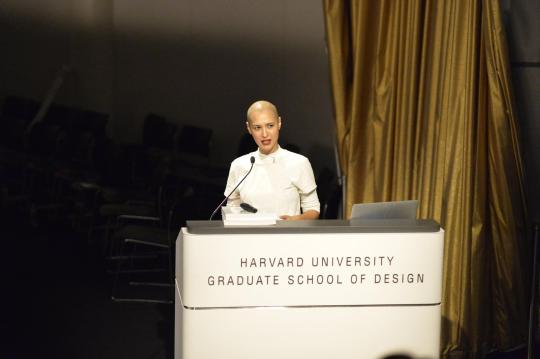

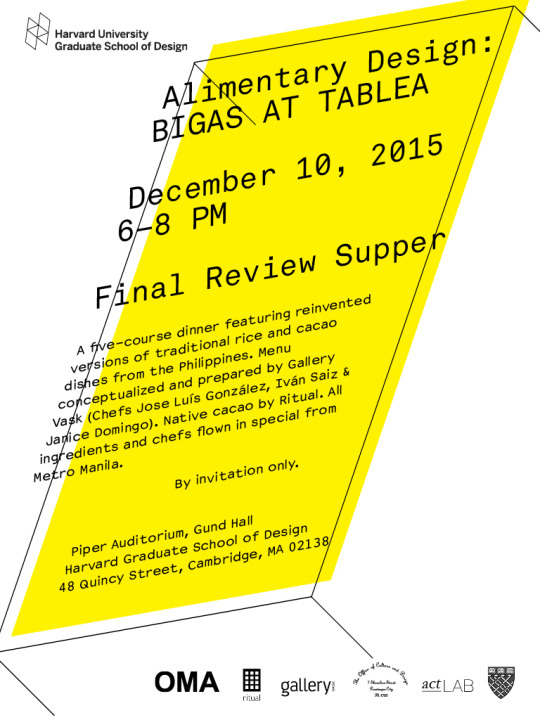

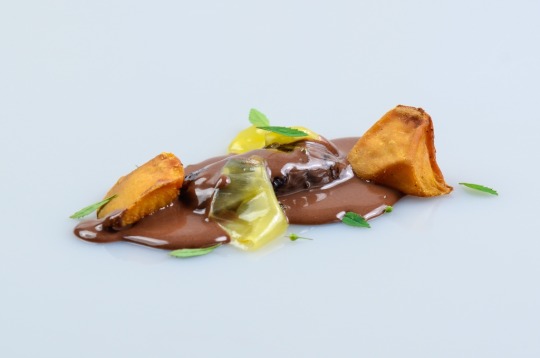
ALIMENTARY DESIGN AT HARVARD GSD WITH OMA, actLAB, VASK AND FRIENDS
Here are some pictures of the lunch time event, the Final Review presentations, the amazing studio warehouse full of sleepless students, the fliers and the food we prepared.
Our lunchtime schedule of food and thought included pandesal, hot tsokoleyt, two talks and a short film showing of Chapter 4 of the Lupang film we made a few years ago with Carlos Casas and Stefan Kruse Jorgensen.
The pamphlet we published for the event had recipes, an essay on tropical ferments by one of our speakers (all around favorite people) Bea Misa-Crisostomo, and other supplementary info. In case you interested, here is a small excerpt from the recipes portion:
INTRO
Here are some recipes. They are traditional variations of the food served at the Alimentary Design final review supper. Plus the actual recipe for the main course. And a couple of extra added bonuses from Ritual’s archive of vernacular food traditions.
Culture and tradition in the Philippines are still transmitted orally, for the most part. How to navigate public transportation in Metro Manila, how to make killer pandesal, how to construct a traditional christmas lantern or parol, or how to build an indigenous Maranaw torogan house... these are processes largely passed on through word of mouth, from one generation of users, chefs and builders to the next. This precolonial, tribal way of communicating knowledge is reflected in some of these recipes. Measurements are eyeballed, cooking times are intuitive, personal preference is allowed and encouraged.
If you’ve ever tried to gather field information of any sort in the Philippines—not just at the level of the rural but also, often, on professional or institutional scales—you would eventually run into a very human predicament: imprecision. Oral transfer of data is prone to extemporization and subjective building upon. This makes synthesizing data into digitally translatable formats and structures more difficult. It also makes the transmission of information, like for example a recipe, with replicable efficiency a more labor-intensive endeavor. There is some to be said, however, about retaining this personable trait, for championing a qualitative and story-like approach to data. Perhaps this is a luddite-esque decision to be making in the era of integer-centric information archivery. We sort of don’t mind that.
We understand that this meal companion is going to end up mostly in the hands of a developed-world audience, so saying that this choice has been made to ensure that Eastern audiences find the oral tradition experience more relatable—or mildly entertaining—would sound great. But it would be a lie. Whether or not these recipes end up in the hands of Philippine bakers and carinderya (small, usually streetside restaurants) cooks from the province is, however, beside the point. The point is that we wanted make the process of following a recipe from a book more human. A bit like asking your lola(grandmother) for help. Some of the recipes are more straightforward, though, combining gravitas information and whimsical digression for language that strikes a balance.
RECIPE #1
BEA’S COCONUT MILK TSOKOLATE
INGREDIENTS
Two handfuls of grated coconut meat
Some water, enough to make two cups
Four cacao tableas
Coconut sugar
METHOD
1. Combine the coconut meat and water. Squeeze some of the milk
out.
2. Strain the milk into your cacao-cooking receptacle. We use a Turkish coffee pot, but you can use a saucepan. On medium heat, simmer the milk then add the tableas.
3. Use a batidor or a wire whisk to mash the tableas and mix the whole thing when it gets hot. Whisk it madly. Like you are creating a vortex to get to another dimension.
4. Serve in small cups, put coconut sugar to taste.
8 notes
·
View notes
Photo


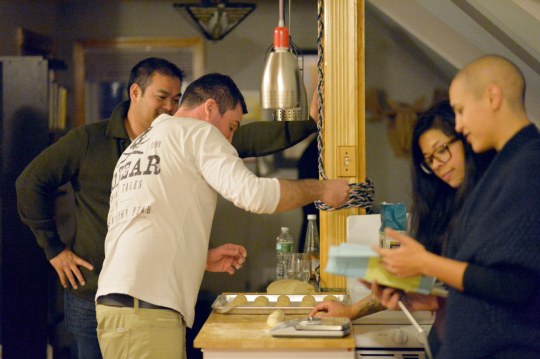
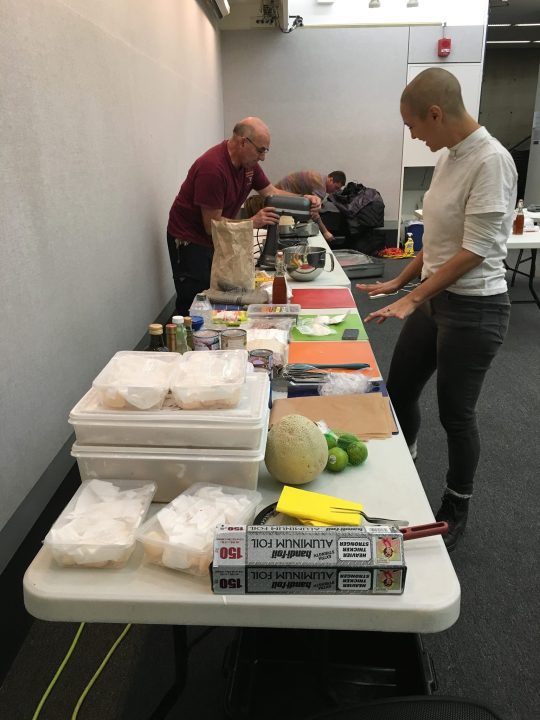
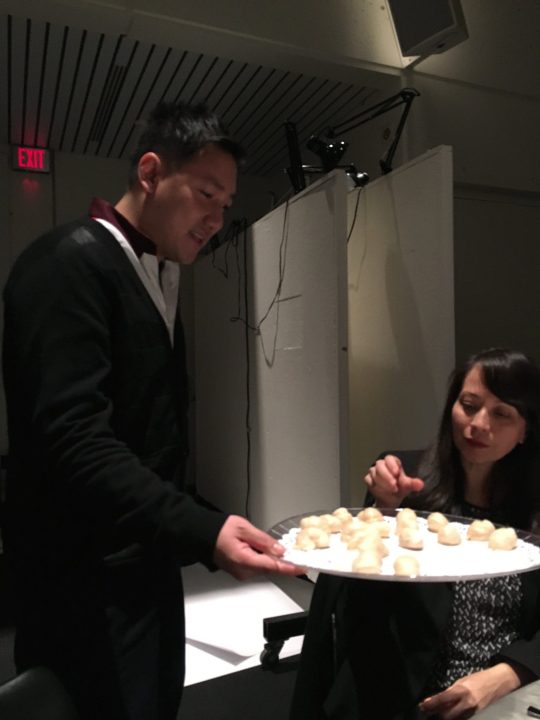

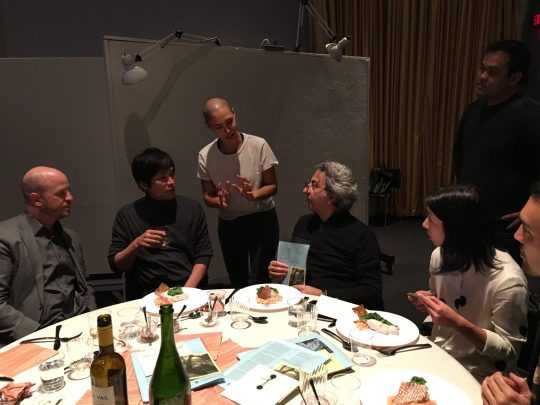
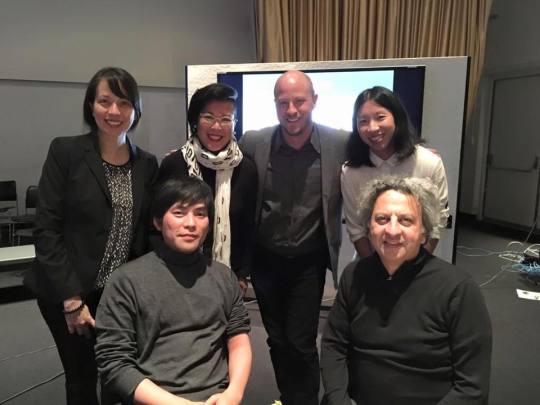
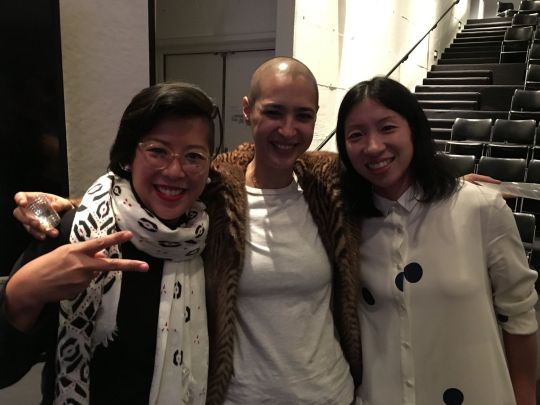
ALIMENTARY DESIGN AT HARVARD GSD WITH OMA, actLAB, VASK AND FRIENDS
So after the NYABF and the lecture at Triple Canopy and at the SAEK in Korea, we were back in Manila for about a month with just enough time to prepare for a return to the US. Doing special projects on the intersections between food, architecture and social practice.
Here’s the short of it, from the small pamphlet we designed for the occasion. Bucket list goal of collaborating with OMA (doing something AMO-ish), CHECK!
ALIMENTARY DESIGN MEALTIME PROGRAM
The final review programming for lunch and dinner was entrusted to The Office of Culture and Design (OCD), a social practice research platform in the Philippines, and actLAB, an architectural design and research studio in New York with an active client base in the Philippines. Both organizations are working together to rebuild schools and provide educational programming for earthquake- stricken communities on the island of Bohol.
The mealtime program is based on two raw ingredients that featured in some of the research projects of Alimentary Design 2015: rice and cacao.
SCHEDULE OF FOOD AND THOUGHT
12 PM
MERYENDA (Snack)
PANDESAL AT TSOKOLATE
Sweet roll and hot chocolate
12-1 PM
TALK
THE BLEEDING EDGE AND THE LAST MILE
Bea Misa-Crisostomo, an agricultural entrepreneur interested in biocultural diversity, was invited to give a talk and provide written insight on Philippine foodways in general and cacao in particular. Aside from running Metro Manila’s first organic general store, Ritual, Bea and her husband also own Casco Cacao,
a community-oriented cacao fermentary and brokerage that actively develops farmer- friendly ways to improve harvest yield and fermentation technology.
Clara Lobregat Balaguer, director of The Office of Culture and Design, adds a final note of insight in a talk that analyzes the preexisting relationships and tangents between the players involved in this project. She tries to shed equal light and shadow on how practitioners from various fields, working sometimes together and sometimes independently, link food, (social) landscapes, design and research in the “bleeding edge of the last mile.”
6-8 PM
HAPUNAN (Dinner)
BIGAS AT TABLEA
Grains of rice and raw cacao lozenges
A five-course dinner that presents retooled versions of traditional rice and native cacao dishes from the Philippines.
Gallery Vask, a fine dining restaurant from Metro Manila run by chef Chele González, were enlisted to prepare a meal. Chele has been engaged in culinary research on the botany and applied uses of native rice varieties, specifically glutinous rice. These investigations, in partnership with the International Rice Research Institute (IRRI), are line with Gallery Vask’s philosophy of serving anthropological cuisine, rooted in the history of Philippine ingredients.
Menu prepared by Gallery Vask chefs Iván Saiz (& Janice Domingo in spirit), with a little help from Boston-based chefs Tyler Sundet (State Park) and Ellie Tiglao (Pamangan). Native cacao by Ritual.
2 notes
·
View notes
Photo

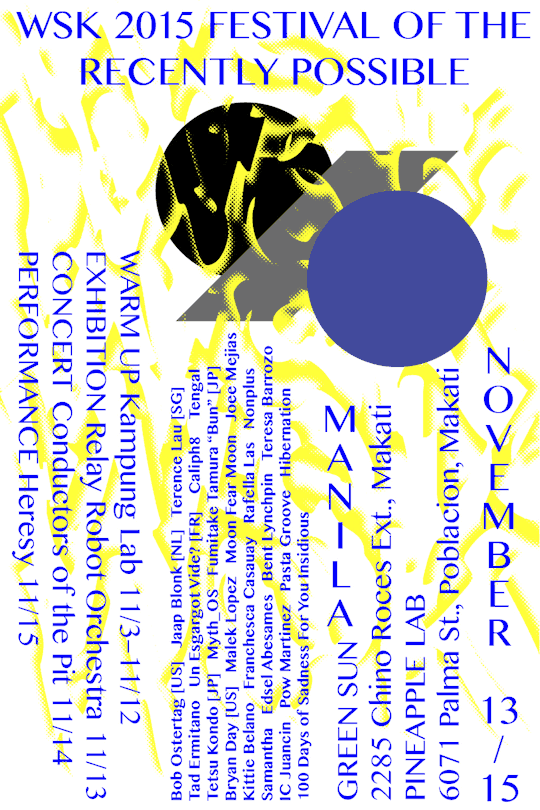
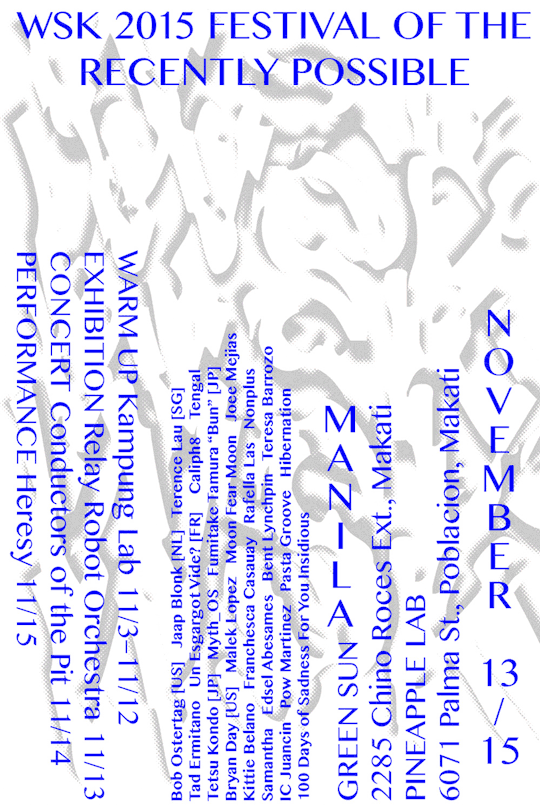
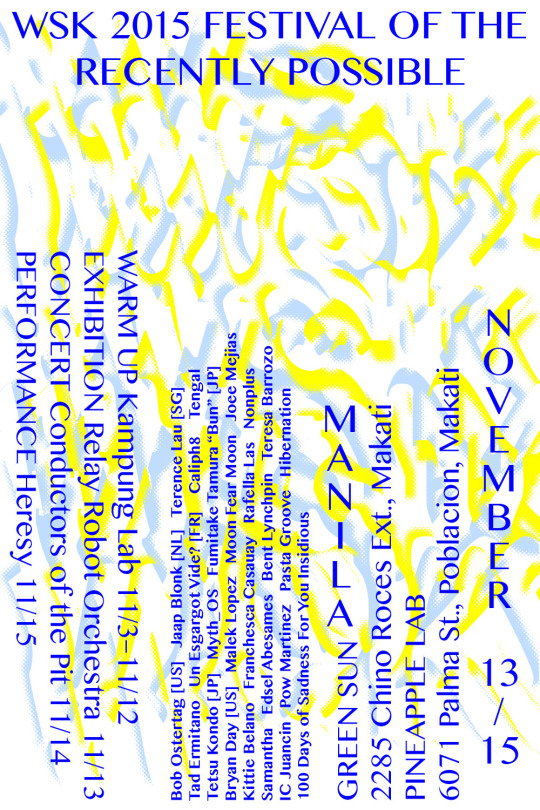


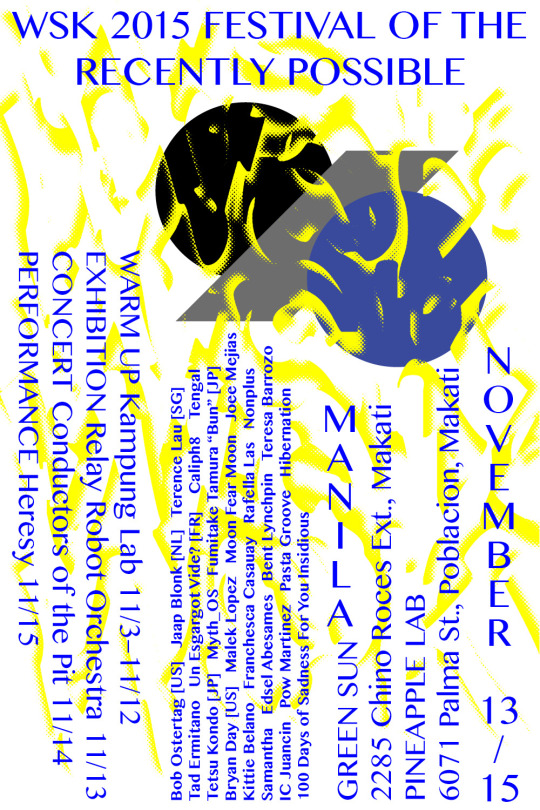

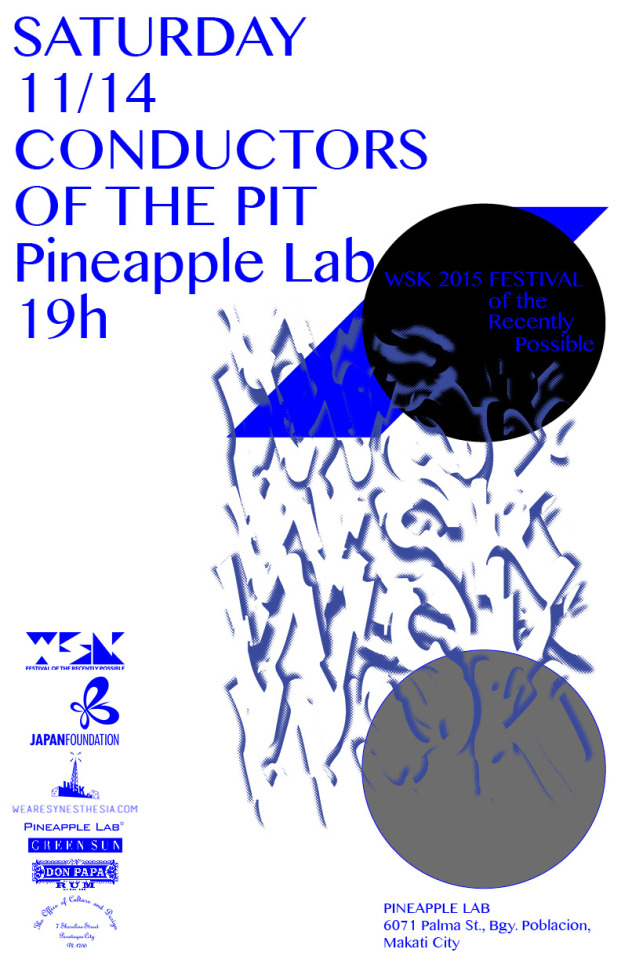

2015 WSK FESTIVAL FOR THE RECENTLY POSSIBLE
So we are hosting Dutch sound poet, Jaap Blonk, for the 2015 edition of WSK Festival for the Recently Possible. He’s performing at Pineapple Lab on Saturday, at 6071 Palma Street, Barangay Poblacion, Makati City.
Google Map Link: https://goo.gl/maps/bWMbx6zjoAB2
Here’s the blurb for the Day 2 concert:
A highlight performance by luminary sound poet Jaap Blonk and synthesizer music pioneer Bob Ostertag [US], instrument builder and sound artist Bryan Day, and a trio performance by WSK alumni, Un Escargot Vide? [FR], Terence Lau [SG] and Tengal [PH].
But if you in Manila and have nothing to do this weekend, there’s stuff going on all weekend. Check the posters for info! We did these as a small collaboration for the festival :)
1 note
·
View note
Link
Our talk at the NYABF featured on Blouin Artinfo site!
2 notes
·
View notes
Photo

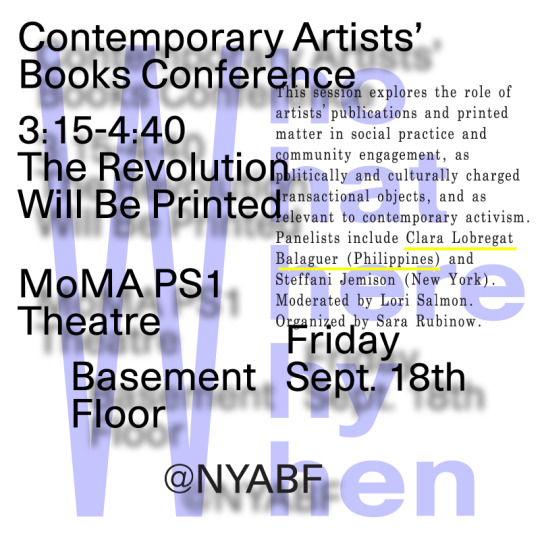

See you this weekend at the New York Art Book Fair! We are booth N25, not N24. Made a mistake in the first flier, and then decided to change the whole flier. Because YES. Extreme drop shadow is our look for FW 2015–2106.
6 notes
·
View notes
Photo
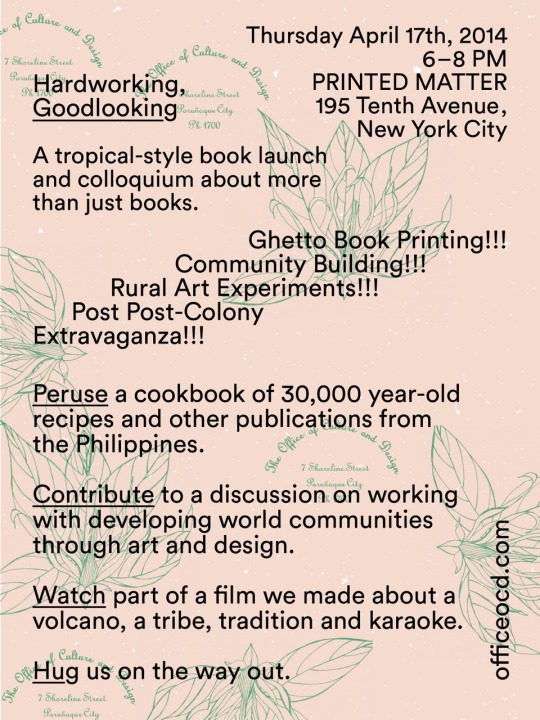
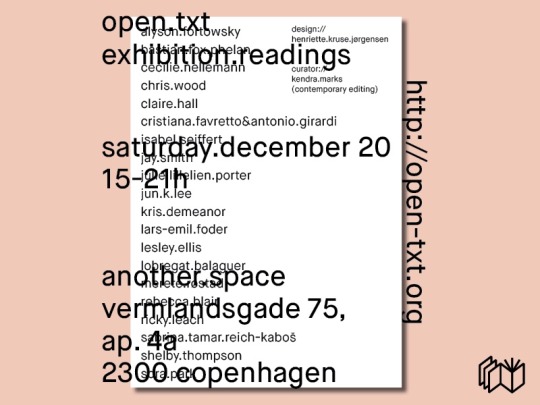
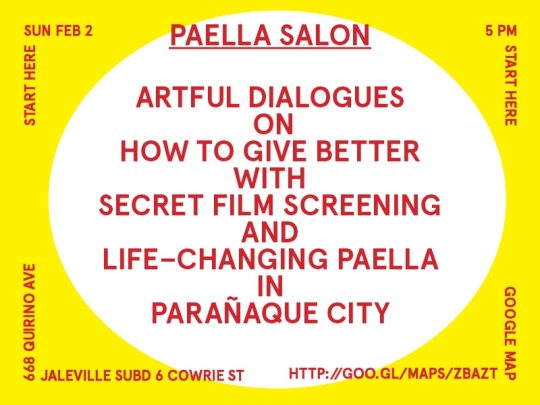


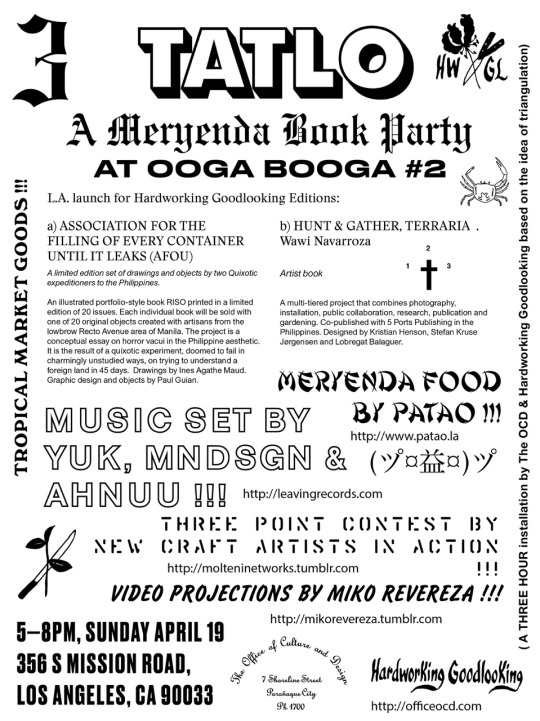
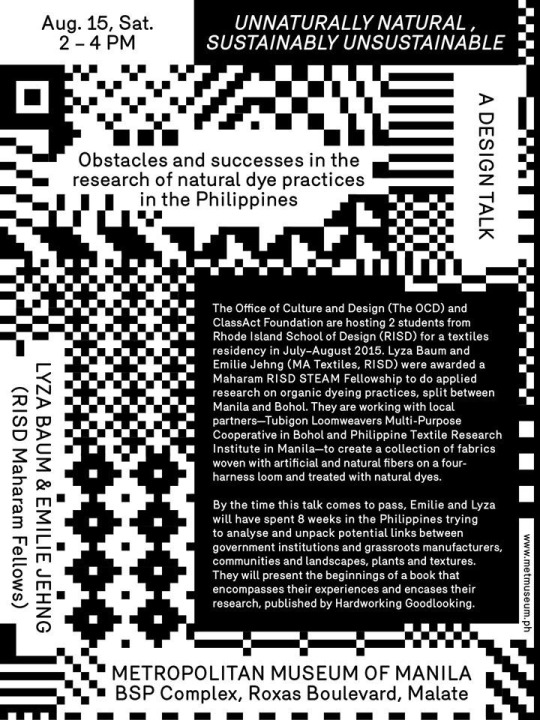
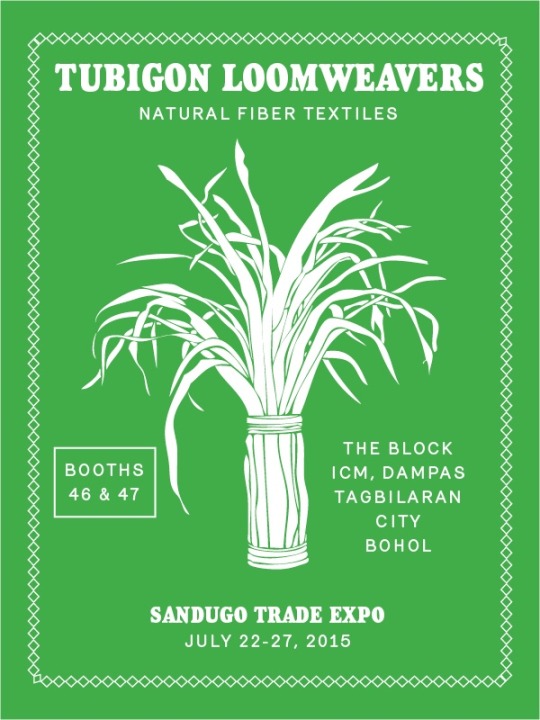
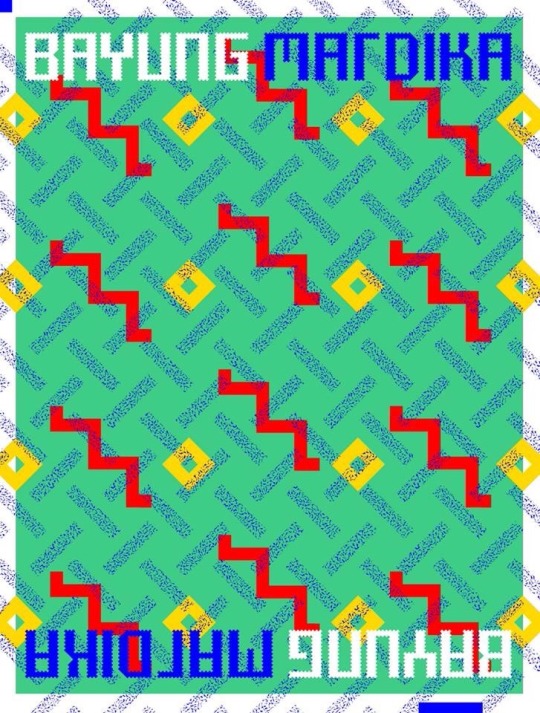
Not throwback Thursday but I believe the other equally horrible #hashtag I'm shamelessly riding on is flashback Friday. So here are some fliers designed by Kristian, our diasporic head of design. :)
5 notes
·
View notes
Photo

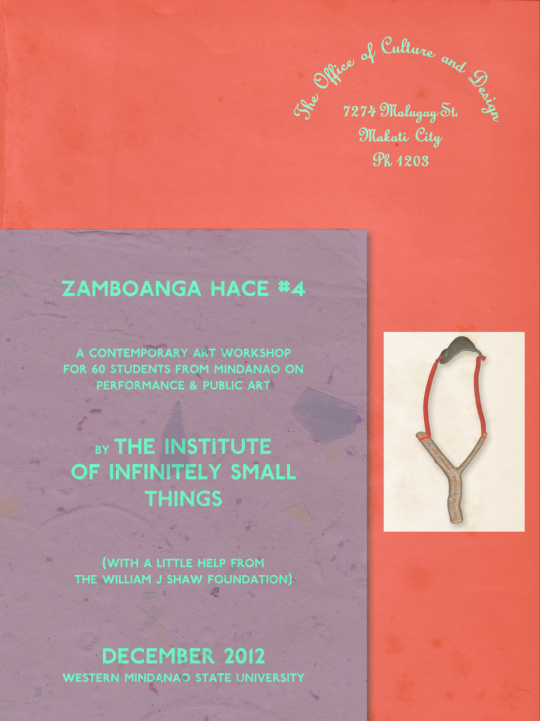
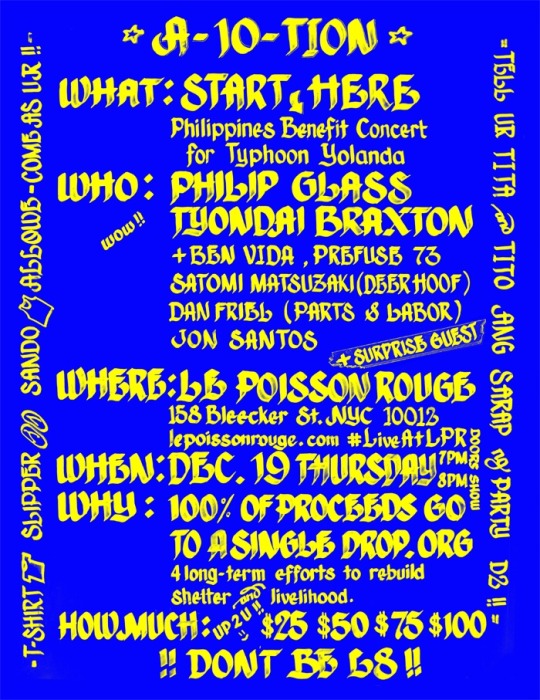



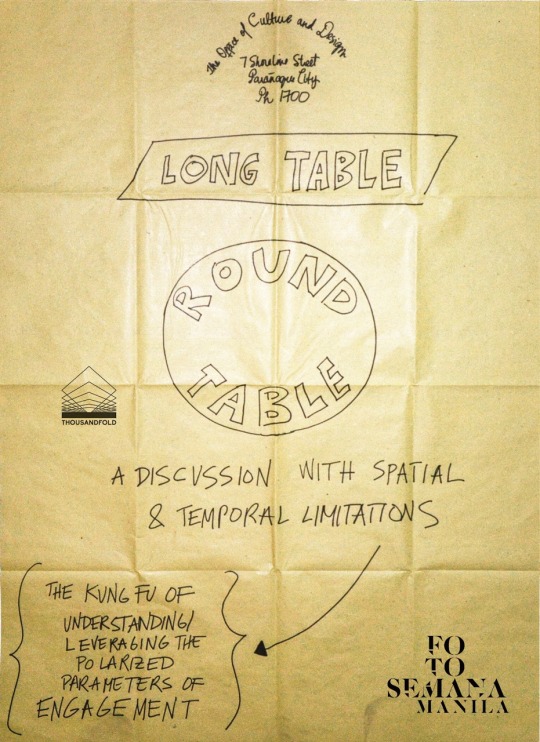
Is it still throwback Thursday? Here are some fliers from our box of memories. These designed by Clara with a little help from our friends! Special appearances by Jumbo the sign painter, Miguel Figueroa, Rita Lino, Carol Montpart and Microsoft Word 2008.
2 notes
·
View notes
Photo

¡¡¡¡¡¡¡INTERNS WANTED!!!!!!!
Hai guise. We are looking for an intern. We have one, who is fabulous, but urgently need someone else to help with prep for a book project (a charming but precarious attempt at archiving the recent history of Filipino graphic design.) Need self-directed people who are serious about actually working and can get along with Mariane (current power intern), who is pretty easy and chill. Oh yeah, must be willing to travel to Parañaque 3 times a week. Any profiles welcome, what's important is that you have initiative, know how to organise and budget your time efficiently, learn fast and like talking to people, rocks and plants about semi-existential things. But if you can work Photoshop or Indesign, extra points for you. Also, we have a resident dog. His name is Pablo. So if you are allergic to dogs, you may still apply but perhaps might need to invest in some homeopathic allergy remedies or something. Send your CV and/or portfolio to [email protected]
2 notes
·
View notes
Photo
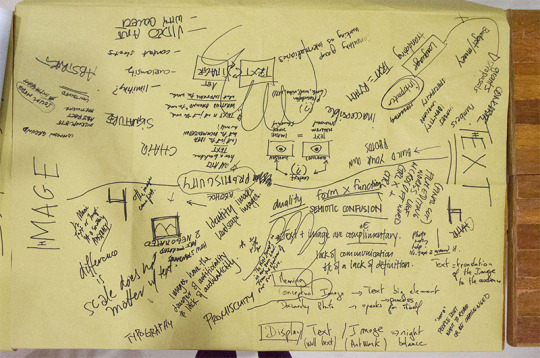

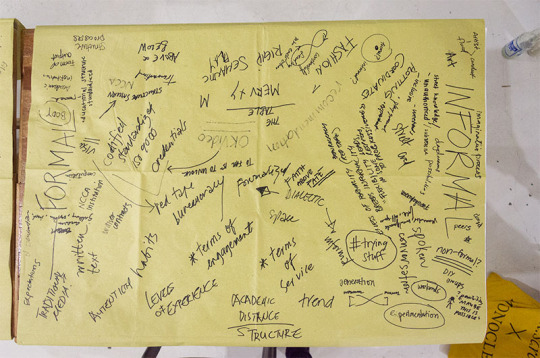
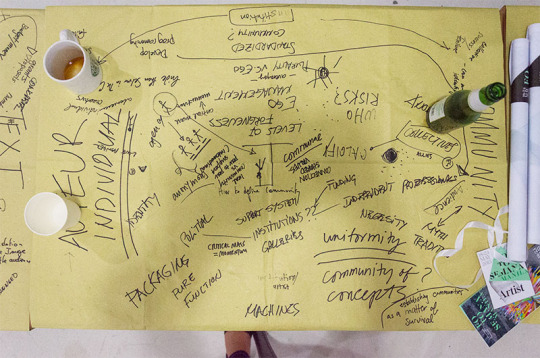

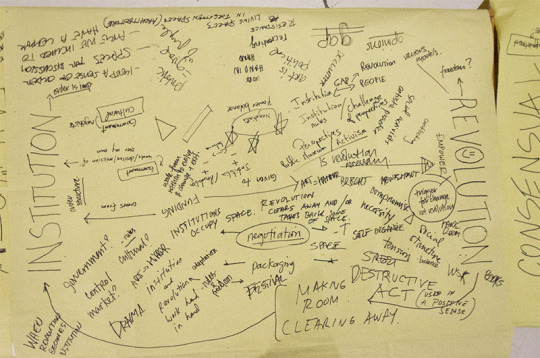

LONG TABLE: THE MANILA PAPERS
Here’s what people actually wrote on the long table, for posterity and because it looks pretty cool.
3 notes
·
View notes
Photo
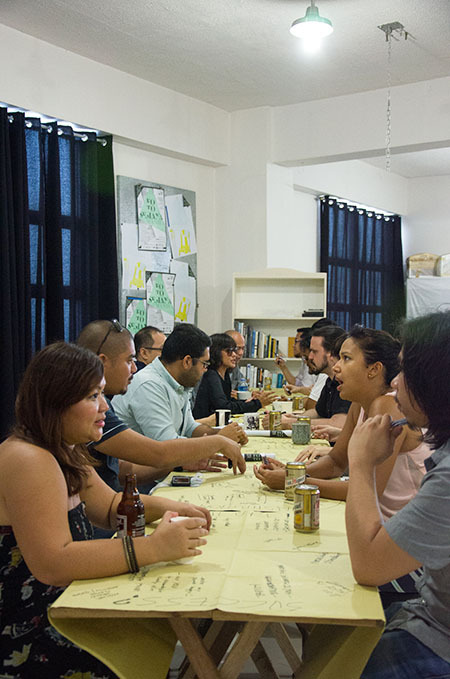

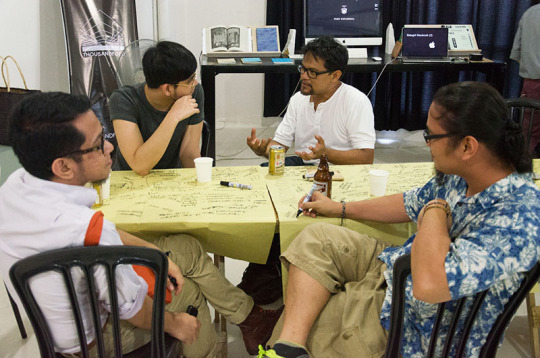
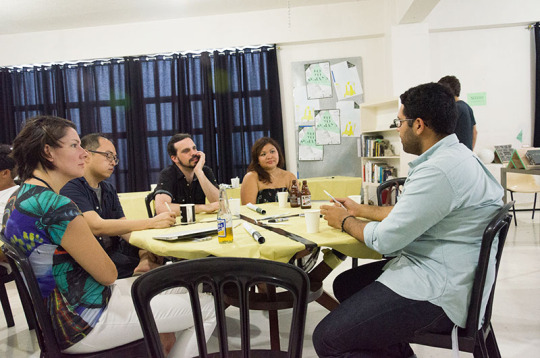
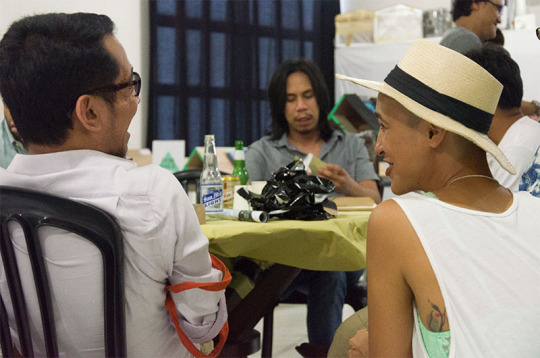
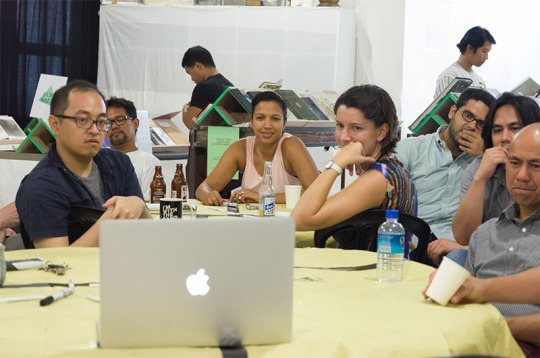

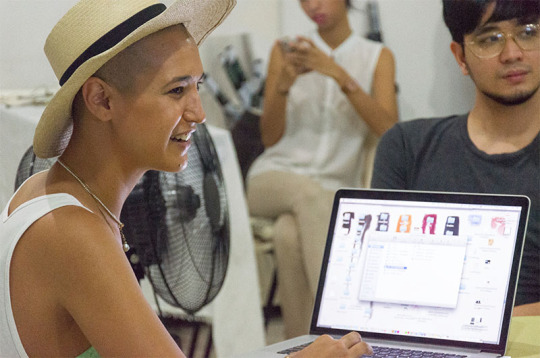
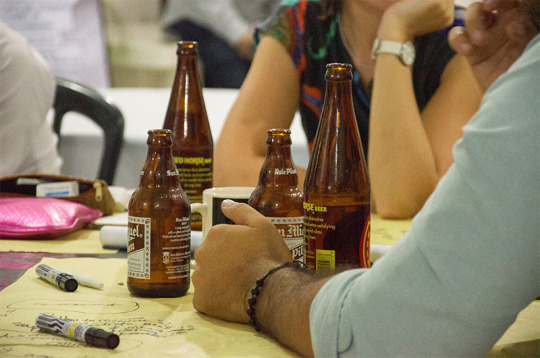
LONG TABLE / ROUND TABLE: A SOMEWHAT POETIC CHRONICLE
Longhand markings on Manila paper are the uninhibited flow of ideas made manifest from thought to writing. Ideas cultivated from an edifying dialogue of polarities between two strangers in a short, rigid 6-minute encounter. If not writing, their hands nurse a cold bottle of beer - standard social lubricant on a summer day. Each encounter a new perspective, a new point of discussion.
Yet in the polarity, there is attraction. Despite the restrictive structure of the discussion, the participants found themselves later and naturally drifting off to informal groups, sharing one table where a free-flowing dialogue between multiple individuals ensued. Indeed, there was a change in how the participants interacted when they moved from the the rectangular long table (static and rigid) to the round table (smooth and dynamic). Content matters, but so does form.
4 notes
·
View notes
Photo
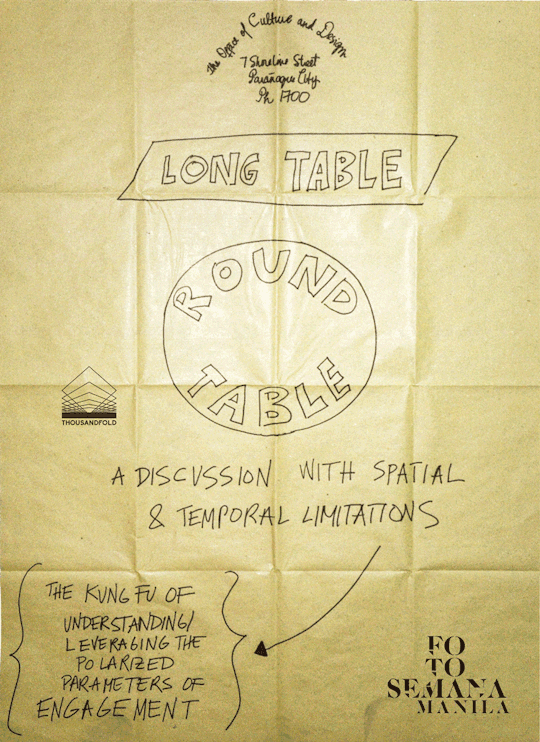
LONG TABLE / ROUND TABLE: A GROUP DISCUSSION FOR FOTOSEMANA MANILA 2015
We have been giving free reign to our obsession with Manila paper in the most recent workshops, as a nod to the fact that most team building, research, educational or organisational group activities in the Philippines rely on Manila paper as a support for their visual aids or group-made collateral. The paper is cheap, as it is made from recycled papers. The brand we like has little coloured and reflective specks, imperfections that add a great texture and remind you of the paper’s past life incarnations.
The flier for tomorrow’s workshop at FOTOSEMANA Manila 2015 revels fully in the affordable glory of Manila paper, which will also feature heavily in the activities we have planned.
HERE IS A DESCRIPTION
Fourteen figures engaged in the creation, diffusion and analysis of visual languages in art, photography, publishing and journalism get together for LONG TABLE/ ROUND TABLE, A discussion group with temporal and spatial limitations. The discussion topic for the afternoon is Kung Fu of Understanding/Leveraging the Polarized Parameters of Engagement. This is an activity put together mid-FOTOSEMANA Manila 2015 Micro Festival, in lieu of a portfolio review that failed to attract any portfolios. It is an effort to make the best of a failed enterprise through the kung fu principle of absorbing negative force and directing it to a positive outcome. The parameters for this and other forms of failed engagement—with either audiences, peers, critics, funders, clients, collaborators or stakeholders—will emerge within two temporally and spatially different discussions: 1) timed, round-robin, one-on-one discussions across a long table and 2) loose, communal, group discussions at a round table. Participants will share their experiences on how they have dealt with the space and time limitations of any project, this one included.
The purpose of this activity is to reach a clearer idea of how shortcomings can be leveraged and successes can resist stagnation within varying terms of engagement.
A thing by The Office of Culture and Design. For the kind folk at Thousandfold and FOTOSEMANA Manila 2015.
FORMAT
1) LONG TABLE
The participants will sit face to face and seven-across at a long table, loosely mimicking the speed-dating format. Each facing pair shall have exactly six minutes to come up with ideas about how engagement through the use of visual language would be affected by one of seven polarized parameters: failure/success, revolution/institution, image/text, agonistic/consensual, auteur/community, insider/outsider, formal/informal. The discussion partners will have to write down, on a Manila paper table cover, keywords or phrases that came up during their discussion. Once the six minutes are up, all participants move one chair to the left to face a new partner and answer a new question. This will continue until all participants have answered all questions.
2) ROUND TABLE
The paper table cover with all the keywords and the participants will transfer to a round table. The discussion will be loosely directed by questions provided by the international reviewers who were supposed to have viewed portfolios via Skype and could not be present at this activity. Participants are encouraged to write, draw or spill coffee on the Manila paper table cover while they discuss the success and failure of this and other attempts to engage with a public through visual languages.
PARTICIPANTS
Wawi Navarroza Artist/Educator Thousandfold
W. Don Flores Artist/Educator
Veejay Villafranca Photographer/Journalist
Sonny Thakur Photographer/Photo Editor Grid Magazine
Renan Laru-an Curator/Writer Disclab
Patricia Levasseur de la Motte Art Advisor/Curator The Philanthropic Museum
Pamela Cajilig Professor/Researcher Curiosity.ph
Nicolás Combarro Artist/Curator
Moritz Neumüller Curator/Writer The Curator Ship
Merv Espina Janitor/Cook Sabaw Media Art Kitchen
Marc Ocampo Writer/Program Coordinator Japan Foundation Manila
Eva McGovern Curator/Writer
Earl Drilon Driver/Spin Doctor Sabaw Media Art Kitchen
Arvin Flores Artist/Director Artery Art Space
7 notes
·
View notes